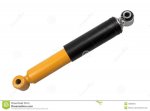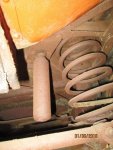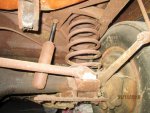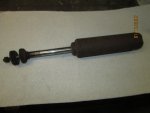It was a shock but not like any I had ever seen.
if what you're saying is correct, there's normally a shackle at ( what on your units would be ) the bottom, so that the shock can be slid over a bolt mounted perpendicular to the action of the shock, like this, which has the bolt mounts on both ends.

of course, your shock simply bolts up straight through the plate on the 'bottom' end, so that's what he used to mount it too the plate.
what is likely happened is that the PO hacksawed off this round 'eye', and simply allowed the bottom end of the shock to swing freely.
which is absolutely bonkers.
It couldn't have worked very well because the rods were bent and they were jammed closed
exactly so. it also wouldn't have worked for **** as a damper, as the shock would have had no effect at all while the spring was extending ( wheel falling into a pothole, say ), and wouldn't damp the spring on compression until AFTER you were well into compression.
the only way to make this arrangement work would be to either change the bottom mounting plate so that you could attach a 'normal' horizontal bolt ( would need a shackle ) to affix the shock too.
i suppose you could try to find a shock that has the same 'vertical' screw type attachment at both ends as what you see on the ones you have and then you could just drill a hole in the lower plate and attach it the same as the upper end is done.
i would be leery of that though, the rear axle is going to move forward and back as it rotates past the pivot point of the control arms and i would prefer at least one end of the shock to be able to rotate freely with that.






